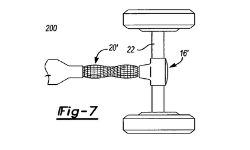The horizon of which inventions are patentable, that is. For the last decade or so, the Supreme Court has been steadily excluding one technology after another from patent protection. The recent series of cases started in 2010 with Bilski v Kappos, which determined that a method of hedging utility fuel prices was not patentable. Then the 2013 Myriad Genetics decision meant that many biotech inventions are not patentable. In 2014, Alice v CLS Bank decision ruled out patent protection for almost all software inventions. The Supreme Court determined that each of these technologies addressed ‘abstract ideas’ or ‘laws of nature’ and did not qualify as ‘patentable subject matter.’ The Court left us with a patentability test so vague that this author submits that it is not a test at all and could lead to any result in any situation.
Those of us in the mechanical and electrical arts wrapped ourselves tight in our comforting wrenches and drill bits, secure in the belief that the evils of ‘abstract ideas’ and ‘laws of nature’ would never come knocking on our door…
…Until 2019, when the Federal Circuit Court decided American Axle v Neapco. The American Axle patent addressed liners, which reduce vibration in automobile driveshafts. The driveshaft was tuned to dampen two types of vibration simultaneously. Inventions don’t get much more concrete than a driveshaft; nonetheless, the Federal Circuit Court concluded that the claimed invention was directed to a ‘law of nature’ and was unpatentable. The American Axle patent claimed the result to be achieved; that is, dampening two types of vibration simultaneously, rather than the specific structural features that dampen driveshaft vibration. The claims do not even address a specific technique to tune for two types of vibration simultaneously. As the Federal Circuit pointed out, the claims would encompass drive shaft designs reached entirely by trial and error. This author believes that anticipation (by every drive shaft ever made) or lack of definiteness would have been better grounds to reject the American Axle claims.
Nonetheless, American Axle has asked the Supreme Court to review the Federal Circuit Court decision and to take another look at patentable subject matter. A number of organizations have filed as amici (friends of the court) to ask the Court to clean up its act. Joining the fray are Senator Thom Tillis (ranking Republican on the Senate Judiciary Committee), Hon. Paul R. Michel (retired Chief Judge of the Federal Circuit Court of Appeals) and David Kappos (former Director of the U.S. Patent and Trademark Office, whose name appears on the Bilski v Kappos decision). The Tillis/Michel/Kappos brief argues that the Supreme Court’s test for subject matter patent eligibility has created ‘a chaotic state of affairs’ and ‘an unpredictable and unstable U.S. patent system’ and is an ‘unintelligible hash.’ The recent changes in personnel at the Supreme Court coupled with the failure of the Court’s current approach might just make change possible.
Regardless of whether the Supreme Court again considers patentable subject matter, the takeaway for this author is to claim a mechanical or electrical invention in terms of the structure of the invention rather than in terms of a desired result. Back to the comfort of my wrenches and drill bits.
– Robert Yarbrough, Esq.


